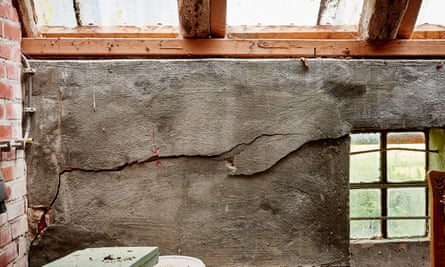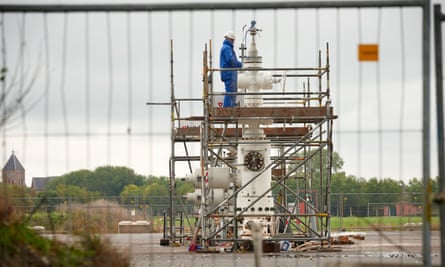Five years ago, Annemarie Heite and her husband, Albert, bought their dream home; a traditional 19th-century farmhouse in Groningen province in the northern Netherlands. The couple planned to raise their two young daughters in this charming corner of the Dutch countryside. “Then, the living was still easy, and affordable,” Annemarie says, her tone bittersweet and nostalgic. Today, their house is scheduled for demolition.
Hundreds of earthquakes have wrecked the foundations of the Heites’ home and made it unsafe to live in. Annemarie’s biggest fear is the safety of her daughters. She points to a room. “This is where my children sleep,” she says, “and everyday I’m just picking up pieces of bricks and stuff from the ceiling.”
Heite fears that her children may not be any safer at school. Her daughter Zara goes to a local primary school that has not been structurally reinforced to withstand strong earthquakes. “I feel powerless. It feels like I can’t do anything,” Heite says. “It’s not like I’m a frantic, hysterical person, but nobody is taking this seriously, not the school or the mayor, no one.”
Next door, Heite’s neighbour’s farmhouse is already a pile of rubble, which yellow JCBs are clearing away. “It’s collapsed. It’s gone,” Heite says. “They lived there for 30 years … and over there behind the trees, they demolished another house.”
Farmhouses like Heite’s are disappearing across the Groningen countryside as a peculiar, profound environmental crisis grips the province. At the heart of it are two oil companies, Shell and Exxon Mobil, and a government that, for two decades, denied responsibility for its actions and ignored the voices of citizens and scientists. The scandal has already cost the oil companies €1.2bn [£880m], but last month a landmark court ruling gave the victims fresh hope that their voices could be ignored no longer. And if they are right, the consequences could be profound: a compensation bill that could stretch to more than €5bn in Holland, an energy security headache for Europe, and an invocation for the world to think about the real cost of burning fossil fuels.

Groningen is farming country – far from outgoing Amsterdam or the cosmopolitan Hague – where impeccably flat green fields stretch out in every direction and the smell of manure is, if not exactly pleasant, somehow pure. Underneath this simple, orderly landscape is one of the biggest and most profitable gas fields in the world. In 1963 the Dutch petroleum company Nederlandse Aardolie Maatschappij (NAM) – jointly owned by Shell and Exxon Mobil – first tapped into the 2.8tn cubic metres of gas reserves. The Dutch government cut a deal with the oil companies, and now it owns a 40% stake in NAM’s parent company. The three parties each made fortunes in a honeymoon period of nearly 30 years. The Netherlands is now the EU’s biggest gas producer, and Groningen, generating billions of euros every year, is the jewel in its crown.
Groningen does not sit on any fault lines, and before Shell and Exxon Mobil arrived, it had no history of seismic activity. But the earthquakes that ruined Heite’s house and many others are, everyone now accepts, manmade. Manuel Sintubin, professor of geodynamics at Leuven University in Belgium explains: “When you extract gas, it changes the pressure in the gas reservoir and causes compaction in the reservoir sandstone, which causes earthquakes.”
As more gas was extracted – the field is about two-thirds empty now – pressure changes deep underground become more severe and unpredictable. Nearly 1,000 manmade earthquakes, ranging from 0.1 to 3.6 on the Richter scale, have occurred in Groningen since the early 1990s. A 3.6 magnitude earthquake is not a terrifying experience, although in 2012 it was strong enough to shake groceries off the shelves in a Groningen shop. But because the earthquakes take place at the shallow depth of 3km, and many Groningen buildings are built on soft clay, the damage caused is greater than their small Richter-scale magnitudes suggest.
When the first earthquakes were reported, NAM and the government denied the causal link between gas extraction and earthquakes. Later, they accepted the link but claimed that any damages would only be minor, and maintained this argument for nearly 20 years, despite growing evidence of major damage to buildings. NAM has received more than 50,000 damage complaints from people seeking compensation.
This year the Dutch Safety Board published an investigation into NAM and the Dutch government’s approach to citizen safety between 1959 and 2014. Until 2013, the report concludes, both parties ignored citizen safety for decades when making decisions, conducting risk assessments and planning research programmes. Instead, they made sure the gas kept flowing, maximised revenues and ignored independent scientific research and advice.

For many of the people affected, the authorities’ indifference had severe consequences – financial as well as emotional. In 2011, Nicolette Marie and her husband, Duco, 52, wanted a fresh start in a new place, after Duco had recovered from a three-year illness. The couple put their house on the market for €225,000, but shortly afterwards the biggest earthquake in Groningen’s history struck and the market flatlined. During the following two years, Nicolette and Duco dropped the price, bit by bit, to €135,000. “We had a lot of people visiting, people come to view bargains,” she says, but after they learned about the quakes they lost interest. They only ever received one offer, of €105,000.
By 2014, the depressed housing market had left Nicolette, Duco and their two children trapped in their remote village, where they watched cracks grow up the walls of their house and worried about the damage the next quake might wreak. Desperate to leave, she applied to an independent committee financed by NAM to assist people who have been adversely affected by the earthquakes. She was disappointed by its response: “They did not buy our home, they did not compensate us for our loss of income due to stress and sickness, they did not cover the cost for psychological help we’ve sought.” The committee told Marie that if she could sell her house, and the sale price was lower than €135,000, it would compensate the difference, up to a maximum of €30,000. “They don’t give a damn,” Marie says.
Four years after deciding to leave, Marie is still trapped in a house she can’t sell. She has now instructed a lawyer to begin seeking compensation. “The only thing that keeps me going is my anger,” she says. “But you can’t do that indefinitely, because anger eats away at you.”
In September, a Dutch judge gave Marie and thousands of people in her situation some potential reprieve. The court ruled that all owners of real estate in areas affected by earthquakes have the right to claim compensation from NAM for loss of market value. It is the first time a company has been held responsible for damaging a market. Crucially, real-estate owners must be compensated now, and not when they sell their property, which in Marie’s case has proved near-impossible.
Jan Brouwer, a professor of law at Groningen university and director for the Netherlands’ Centre for Public Order and Public Security, says it is also the first time that NAM admitted in law that it was responsible for the earthquakes, although it had implicitly accepted liability for years.
Legal discussion on how to evaluate damages are now under way between NAM and De Haan, the law firm that brought the class action, although NAM has also appealed the ruling, so a final settlement is some way off. It is too early to say what NAM’s full liability might be, but Pieter Huitema of De Haan thinks the market is damaged enough to cost NAM more than €5bn, in hundreds of thousands of payouts.
However, the judgment is only concerned with damage to the housing market, and is no help to anyone with widening cracks in their floors or collapsing walls. In these cases, individual citizens must pursue their cases independently. But NAM has a reputation as a hardball negotiator and getting a fair settlement is allegedly a difficult task.

Jur Huizinga, 62, knows that to his cost. His house is also scheduled for demolition. He is a stout farmer with a broad face who grows sugar beets, sweet potatoes and winter wheat on a 400-acre plot. Four generations of his family have lived and worked on this land since 1864. Last year the government ordered the demolition of Huizinga’s home after earthquakes irreparably damaged its foundations. He now lives with his wife in a dismal “temporary unit” built out of several Portakabins. Here, he eats his meals in a poky, plastic-floored kitchen and contemplates the destruction of the only house he has ever lived in.
Huizinga has been trying for more than a decade, unsuccessfully, to claim compensation for damages to his house. He says: “[We’ve been] negotiating for 12 years. For the first six or seven years, they denied that the damage came from earthquakes.” NAM now accepts the damage is caused by quakes, but disputes the cost of replacing his house, which has frustrated Huizinga. “They take you for a fool,” he says. “We have to build a new house, and a contractor calculated the cost is nearly €800,000. NAM made a calculation and it was €200,000.” Huizinga also resents NAM’s dual role in this process: “The company who destroys your house also says how much money you get.”
One independent damage-assessor says NAM routinely acts like this. The assessor says: “NAM always denies the cause of the damage is an earthquake, and puts the house owner in a position to provide absolute proof, although there are no signs for reasonable doubt,” he says. Then, if it accepts liability, “NAM always starts with a very low offer and waits to see whether the house owner is able to negotiate properly or not. Then they use specially trained negotiators for the tough ones.”
NAM says it has been inundated by damage complaints since a big earthquake in 2012, and in the past three years it has received more than 50,000 compensation claims. In an effort to process complaints more efficiently, it now funds a dedicated unit called the Centre for Safe Living, which is operated by two NAM contractors. NAM says that most cases are for small amounts of money and “in 88% of the claims, compensation is offered to the house-owner” and that “95% of the inhabitants agree with the first offer for compensation”. It says there were a small minority of hard-to-resolve cases.
The damage assessor adds: “NAM’s strategy is to solve the minor problems and focus on that in the media.” He says he has watched the fire in citizens slowly peter out over years of negotiations. Claimants suffer weight loss and develop health problems from the stress. But Huizinga is adamant he will continue fighting. “We live here so long and it is not our fault. I cannot agree that I don’t get back what’s rightfully mine. It is injustice. If you give up, what then?” NAM says its latest offer is €500,000.
The experiences of Heite, Marie and Huizinga are typical in Groningen, and anger is are widespread in local communities. Even the region’s churches have come together to express their outrage. Public trust in NAM and the government is reaching an all-time low. Meanwhile, the earthquakes have forced the Dutch government to cut production in Groningen, from 54bn cubic metres (bcm) in 2013 to 30bcm this year, in a bid to reduce risk. Critics say this is not enough, with some calling for a lower limit of 21bcm, and others demanding a total shutdown.

But the effects of this cap will be felt in Westminster and Brussels. The Netherlands was the EU’s biggest gas producer last year, with around 15% of total supply, but the cap in Groningen has caused the country’s production to plummet by 58% to its lowest level in 30 years. This gives UK and EU politicians a headache and exposes them to potential embarrassment, because it makes them even more reliant on Russian gas. Russia is already the top importer to the EU, but with the situation in Ukraine still tense and new rifts emerging over Syria, Europe is seeking to be less – not more – dependent on Vladimir Putin.
As Europe looks on, a government effort to make reparations is under way. In November 2013, an independent committee recommended that NAM invest roughly €1bn into Groningen during the next 20 years. But a report commissioned by the Groningen government estimates the cost of repairing properties and protecting them against future earthquakes at €30bn during the next 30 years. There is also concern that authorities are not acting fast enough.
Brouwer says human lives could soon be at risk: large buildings such as schools, offices and apartment blocks are not built to withstand quakes of high magnitudes. He says the authorities could be held criminally accountable in future for their failure to act now, and believes that government bodies are violating the human rights of Groningen citizens by failing to exercise the precautionary principle, which holds that to protect public safety, officials should err on the side of caution.
An earthquake of magnitude 4 or 5 is now considered possible, and could strike anytime, which means structural reinforcements should be made immediately. Sintubin says: “This is a bit like Russian roulette. You have to start from the premise that ‘the big one’ can happen tomorrow, in a week or in 50 years.” He adds that the St Walfridus school, and all of Groningen should now be practising earthquake drills like the ones done in California.
But in the sleepy countryside there are few signs that anyone is taking the threat that seriously. In February, as the Dutch parliament debated the future of gas extraction, it was left to the community’s Christian leaders to sound the alarm. In a chorus of protest as ominous as it may be futile, the churches of Groningen, most of them now damaged by the earthquakes, rang their bells.

Comments (…)
Sign in or create your Guardian account to join the discussion